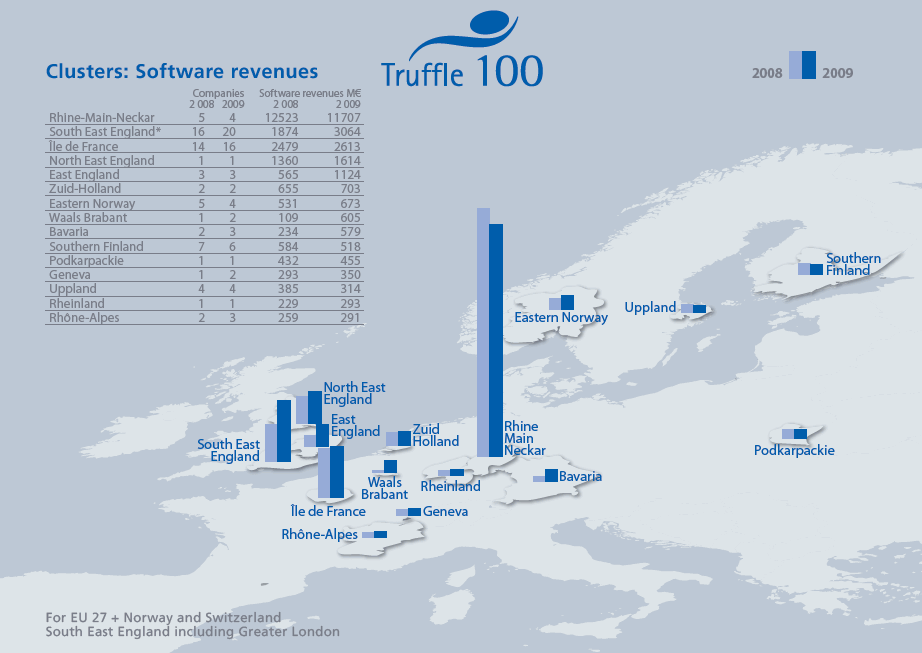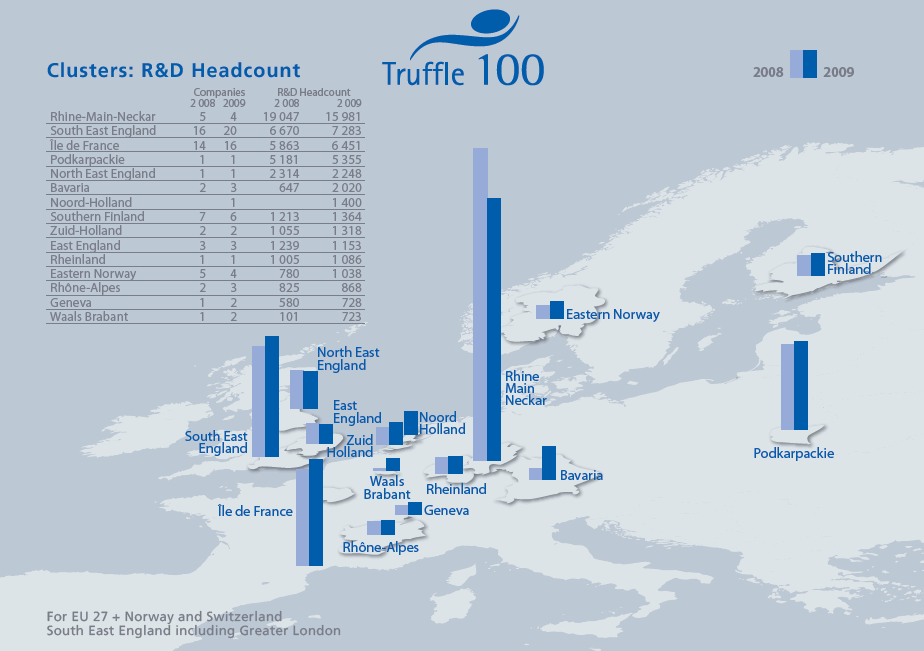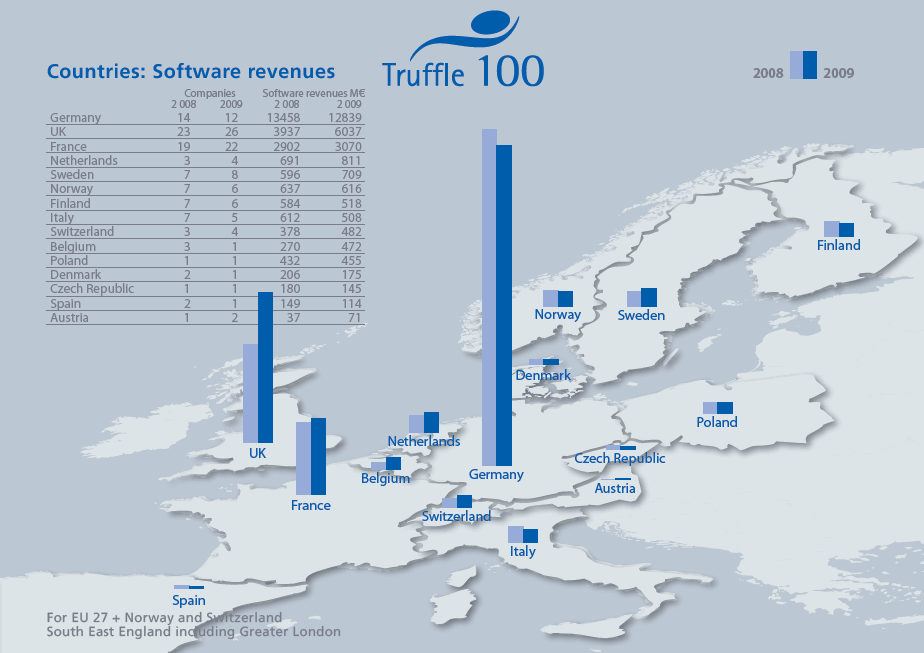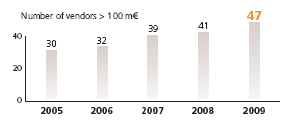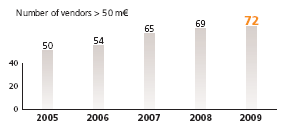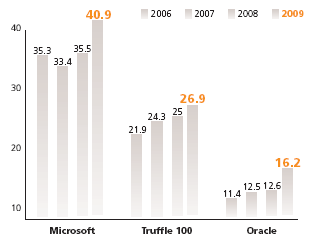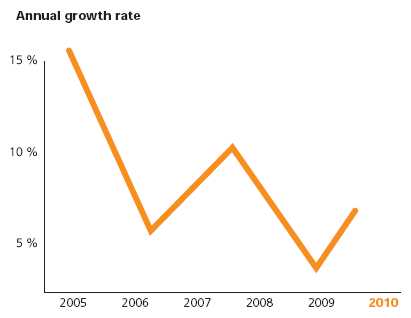Bernard-Louis Roques: General policy on IT The latest data from the Truffle 100 show European IT, and particularly the software industry, is lagging way behind its US counterpart, and shows no tangible
sign of catching up.While US software vendors are recovering form the global crisis and have the financial strength to become predators again, it is getting more and more difficult for their European counterparts
to keep up with the challenges.
Software vendors are not considered a priority industry, which is all the more so regrettable that they are one of the most efficient, profitable and powerful engine for qualified job creation.
As the new European IT Commissioner, do you have a plan to curb the trend and promote European software vendors? Any short term plans to channel more resources into European IT research and development?
Neelie Kroes - EU Commissioner for Information Society & Media
Neelie Kroes: Yes! I am pushing very hard for a significant, but affordable, increase in the European Commission ICT R&D spend. Now is not the time to cut back on these sorts of very
efficient investments. Why? Because investing in ICT research is one of the most fundamental ways we can continue to increase our standard of living and keep the economy in good health. ICT innovation boosts productivity
in all sectors. But the answers are not always about more money. And the money we do spend need shouldn’t necessarily come from government, especially not the kind of money that leads to subsidy dependency.We have seen
the effects of that in some other industries. I believe that the European software sector is better off on a different path.
What we do need is more partnerships to share risk. We do need better and more innovation-friendly public procurement to boost fledgling markets. We do need the EU to help make collaboration easier and to ensure SME can participate in our programmes without
going through administrative hell.
In other words - people can't expect the EU to do everything, we are never going to match either at national or EU level the sorts of money the US puts into defence research. But we can be smarter, by pooling our resources with Member States and by procuring
research in new, more competitive ways.
Bernard-Louis Roques: R&D Programs
The Truffle 100 is highly representative of the European software industry. All but 3 top 100 vendors have revenues below
€1bn. 80% of the Truffle 100 have revenues below €250m. This is an industry of SMEs, that are creating value and thousands
of qualified jobs year after. They invest massively in R&D, mostly in their home markets
R&D Programs are considered to be one of the key drivers for growth. Increases in commitments to ICT under FP7 have been
announced (from €1.1 billion in 2010 to €1.7 billion in 2013).
What is your program in this regard and what actions do you intend to take? Can you give a few figures?
Neelie Kroes: We have to take concrete action that is what I am pushing for, and the standard I should be held accountable to. As someone who has been involved in small businesses my entire
life - either working or teaching or regulating in the field - this is something I take very seriously.
Our first concrete action is to pilot a new “light and fast” access scheme for SMEs in the 2011 FP7 funding call, totalling some 780 million euros. And we will be investing hundreds of millions in the next generation network and service infrastructures,
in robotic systems to help with ageing, in electronic and photonic components, and in digital content technologies. There is funding for pressing socio-economic challenges too.
In the longer term our actions must be about supporting a better ecosystem for ICT entrepreneurship. Our first piece of work must be in improving the attractiveness for venture capitalists to invest in European SMEs. Our SMEs can do brilliantly - 7 of
the 25 firms that went public or were acquired for over US$1bn since 2004 are European. They also tend to be more efficient in using the capital they do attract. But not enough capital is on offer and sometimes it is
not available at the most important stages. The guys at Skype went to 26 different European VC firms and couldn't even get €1.5m. So we can't pretend this isn't a known problem.
Second, we need to build new linkages between finance and SMEs. Those offering grants, Business Angel / Venture Capital support, loans and public procurers need to communicate better. Without more coherent support we won't get enough SMEs going global.
They will die or hit national ceilings.
Bernard-Louis Roques: Simplification of processes
Unlike their US counterparts, the vast majority of SMEs find it too difficult and complicated to access the European R&D
programs. They have very limited resources to dedicate. They are reluctant to get involved in the process because they think
the administrative workload is too heavy. The process is considered too lengthy, while the chances of getting through are
extremely low. There has been very little increase in the participation of the SMEs until now.
What set of actions could you take so as to redirect more of the R&D to the small vendors who need it the most and who
represent the most efficient use of funds? Any short term plans measures for simplifying the implementation of the EU R&D
Framework Programs?
Neelie Kroes: I agree that the EU paperwork is currently too much. We want the paperwork to be lighter and that is starting as of 2011. But in trying to improve we also have to remember
recent progress.We already have set amounts of the money reserved for SMEs. In FP7 SMEs can claim 75% of costs for a given project, up from 50%. And in state aids provided by national governments, there are now dozens
of categories of aid that do not require pre-approval from the Commission. These range from consultancies to participation in fairs, from industrial property rights costs to costs of adapting to environmental standards
and support for start-ups run by female entrepreneurs.
In trying to change the system to better exploit our ICT potential, we need close cooperation with the research community. There must be an understanding that in the current economic climate all public investments will continue to require clear justification.
Essentially, I am arguing for increases in spending at a time when most other budgets are being cut. We won't win that funding without a strong case, and no-one should expect miracles.
Bernard-Louis Roques: Small Business Act
Year after year the Truffle 100 reveals that the vendors view the Small Business Act ('SBA') as the 1st set of public measures
that could stimulate the software industry. The competition with US vendors is unfair because they have been boosted by
a very efficient SBA framework for 60 years. Until now the role of the Commission has been limited to inviting Member States
to consider local legislation, or issuing a Communication on the pre-commercial procurements.
What are your views on the matter, and what are your intentions and plans?
Neelie Kroes: It is absolutely true that many of the actions most helpful to SMEs are in the hands of the Member States. I don’t have the powers to change labour or tax laws, for example.
I can only flag the issues, which - I have to admit - can be frustrating.
But what I have always done - when at DG Competition and now with the Digital Agenda - is try to make access to state aids and other public funding as flexible and open to SMEs as possible. I also acknowledge that software is one of Europe's relative
weaknesses and I have observed that administrative burdens and differences in legal systems can contribute to holding European SMEs back. This means that the public sector carries a clear responsibility for making the
changes required to allow the EU software industry to breathe and grow.
It is important to the bear in mind the “virtuous circle” I am trying to stimulate across all digital markets, and not just software. Better networks drive demand and create new opportunities for software use. A real digital single market opens new doors
for the software industry. New content and new services, such as software, drive the other forces. And the field of software is expanding well beyond the traditional packages - the world of apps is fascinating and exciting
and I hope entrepreneurs use their initiative to lead those trends.
Bernard-Louis Roques: Venture Capital
Most European vendors are too small also because they are undercapitalized. They need more Venture Capital and bank
financing. This is an area where today's dominant world leaders,mostly American, were start-ups financed by Venture Capital
less than a generation ago.
In the past the commission has developed specific “financial instruments” under the CIP to support equity investment. The
2007-13 CIP has several schemes and a budget of over €1billion to facilitate access to loans and equity finance for SMEs
Are there any plans to bolster Venture Capital?
Neelie Kroes: As you say, the Commission is working hard to develop innovative financing solutions including ways to support venture capital. I must stress that the process of improving
the venture capital environment is a long one. It's a cultural issue as well as a policy issue, and here as well we find fragmentation and an absence of a true internal market. The VC industry itself may also need to
develop more specific expertise in the ICT markets. I recently spoke to SMEs and start ups in the area of healthcare, eHealth and Ambient Assisted Living. They complained of the difficulty to get funding and the shortage
of specific knowledge of their market among VC firms. I hope this is not a widespread problem, but I suspect it might be.
We can't go on with our firms getting less than 1/3 of the funding that similar firms in the in US, but we also need to find ways to ensure European firms remain more efficient that US and other firms in using the capital they do get offered. We are more
efficient now, and that is an advantage we can't afford to lose. And we also need European firms to think bigger - they should have global ambitions. If we scale up the vision and offer those visionaries more cultural
support, the pitch becomes more attractive to investors.





